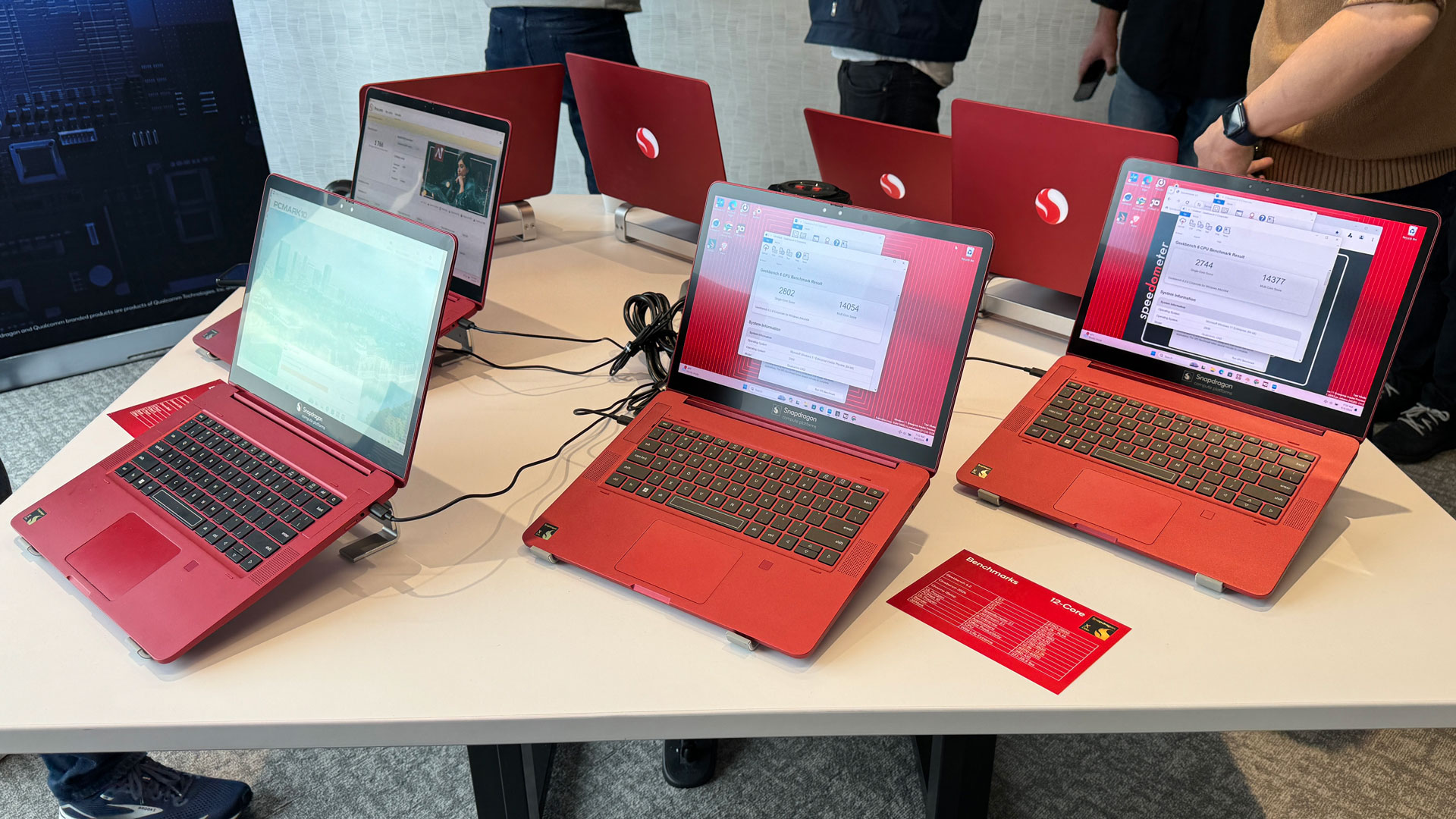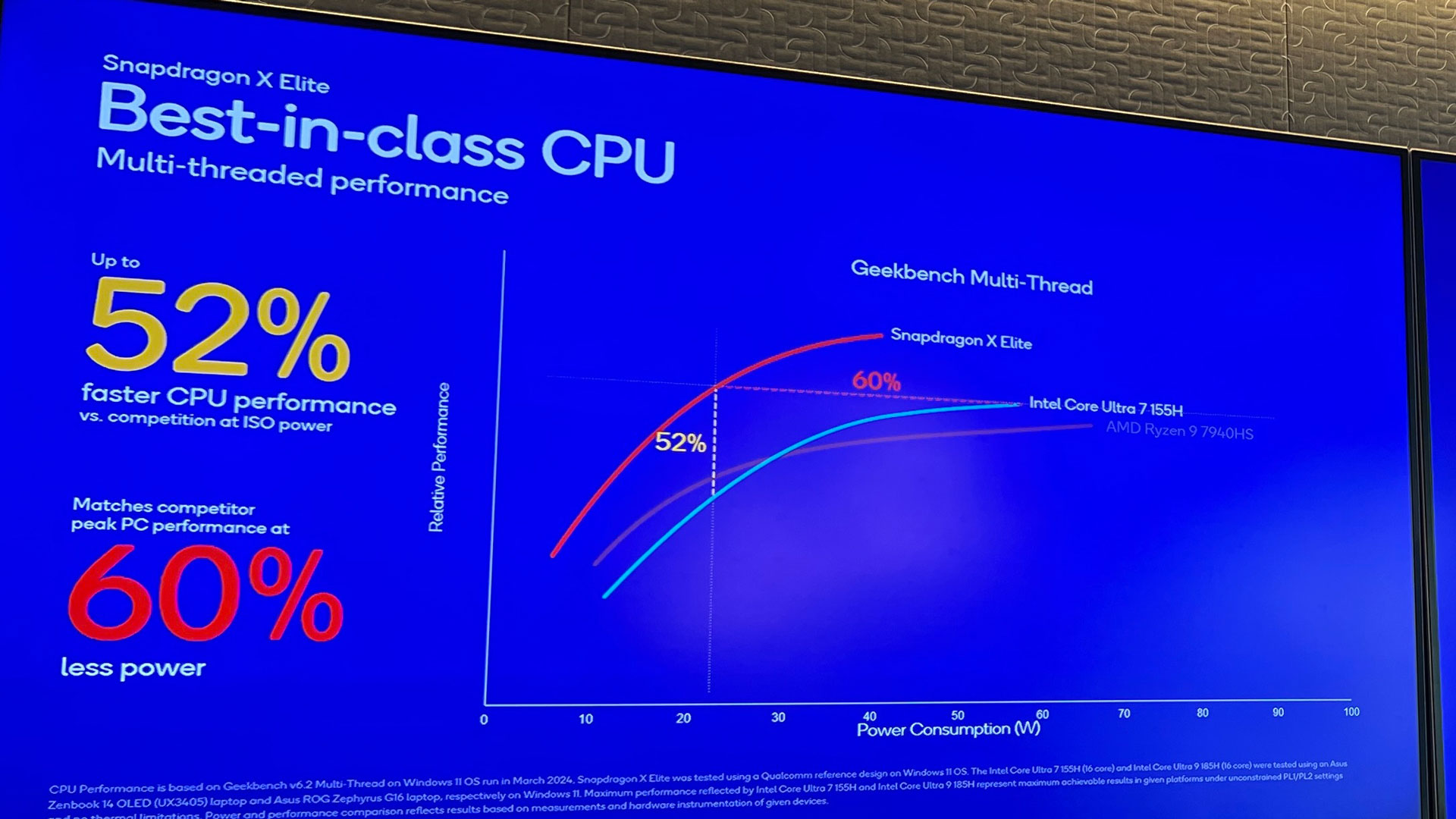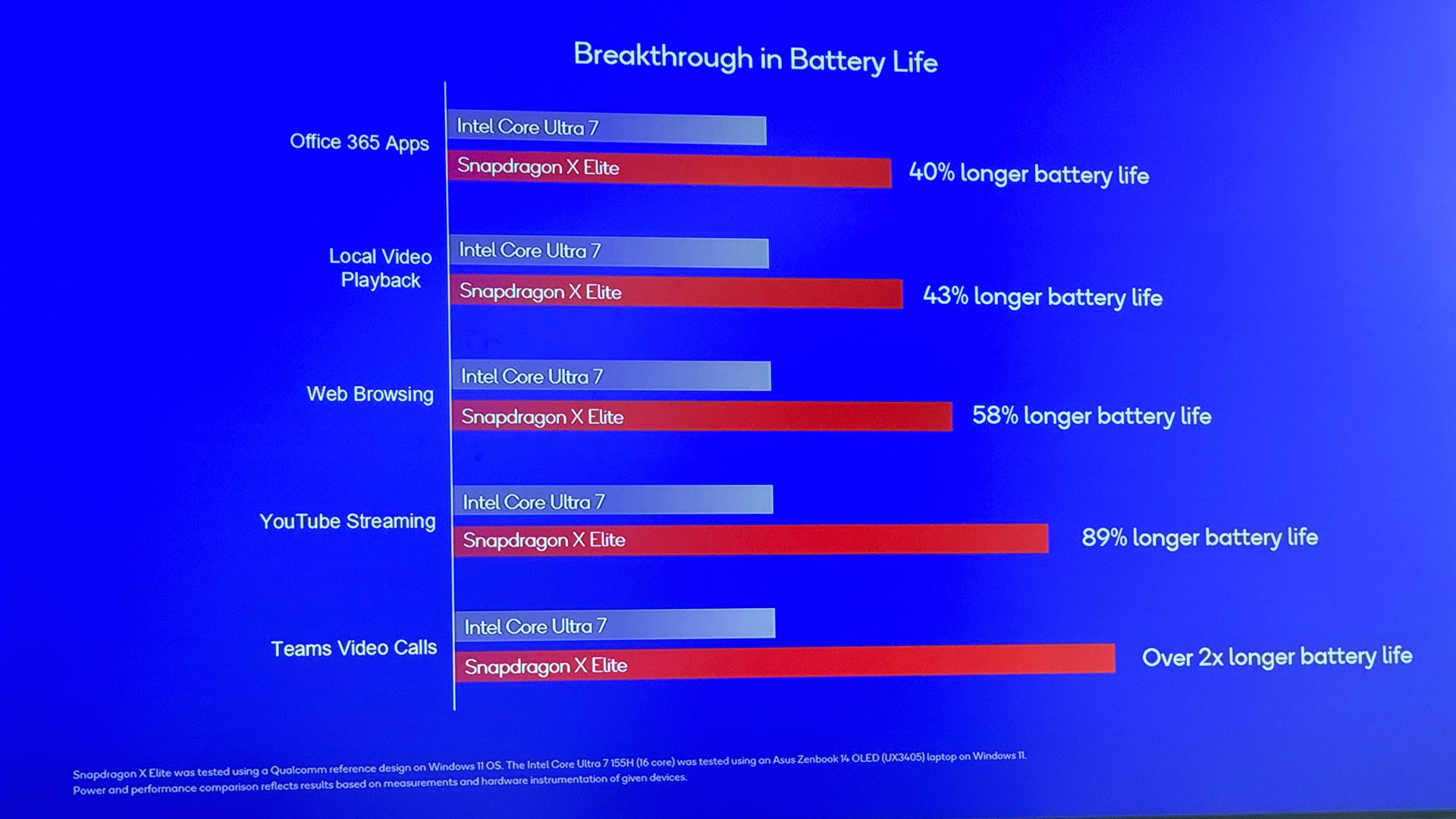I went hands-on with two different Qualcomm Snapdragon X Elite chips as the company claims it will beat Intel's Core Ultra
Qualcomm is continuing to show off its Oryon-based Arm chip ahead of its mid-2024 launch.

It feels like we've been talking about Snapdragon X Elite for a while. It was announced back in October and has seen its fair share of performance leaks. But, for the first time, Qualcomm let us run some tests on the chip.
At a press event in New York, I was able to actually take a look at some laptops using the X Elite in Qualcomm's striking red reference design. Of course, there are some caveats — the tests were pre-selected and preinstalled. Everything was running in Qualcomm's carefully prepared environment. There were many laptops, but of the ones I checked, they were running on Windows 11's balanced performance profile.
In fact, there were multiple configurations going around. Most interesting is that there were three versions of Qualcomm's processor floating around:
- Snapdragon X Elite X1E80100, paired with 16GB of RAM
- Snapdragon X Elite X1E84100, paired with 64GB of RAM
- Snapdragon X Elite X1E80100, paired with 32GB of RAM (this machine was being used for AI demos)
The first two were on easily accessible computers with the benchmarks on them. The X1E80100 was described by Qualcomm reps as more of a standard version of the chip, with Oryon cores running at 3.4 GHz, while the X1E84100 was touted as a binned version, going up to 3.8 GHz. It's unclear how Qualcomm will go about naming these configurations for the mass market.
Updated Intel and Apple Comparisons
Qualcomm took its time to update its own claims now that Intel has released its Core Ultra chips and Apple has moved onto M3.
In terms of Apple comparisons, Qualcomm was a bit thin, only covering multi-threaded CPU performance in Geekbench 6. Qualcomm claims the X Elite beats the M3, 15,610 to 12,154. Single-threaded performance wasn't mentioned, nor graphics. And Qualcomm didn't bring up the M3 Pro or M3 Max, either.

The Intel comparisons were more detailed and more damning. Qualcomm spent plenty of time going after the Core Ultra 7 155H (tested in an Asus Zenbook 14 OLED). In single-threaded performance, Qualcomm says the X Elite is 54% faster than the Ultra 7 155H using the same amount of power, and that it matches the Ultra's peak performance using 65% less power.
In multi-threaded performance, it claims 52% faster CPU performance at the same power or matching peak performance at 60% less power.


Qualcomm is also claiming some victories against the Core Ultra 9 185H (tested in an Asus ROG Zephyrus G16). In single-thread performance, Qualcomm claims 51% faster CPU performance at the same power and matches peak performance using 65% less power. With multi-threaded performance, those numbers become 41% and 58%.


On the GPU side, Qualcomm claims that its graphics are 36% faster than what you find in the Core Ultra 7 155H at the same power, and that it meets peak performance at 50% less power. These comparisons weren't made for M3 or Ultra 9.

Additionally, Qualcomm claims that the Snapdragon X Elite will offer "breakthrough" battery life, though the company hasn't said what size batteries they will use (or if OEMs will have a variety of choices). Still, the company claims it can provide up to 40% longer battery life using Office 365 apps, or more than twice as long when on video calls. Since Qualcomm isn't shipping its reference design, I really want to test this myself. It could make or break the whole experience.
Get Tom's Hardware's best news and in-depth reviews, straight to your inbox.

Qualcomm also claimed that its chip is faster than the Ultra 7 155H at web browsing (20% faster in Chrome, 57% faster in Edge, 15% faster in Brave) according to the Speedometer 2.1 test, and suggests that app speeds range from 7% faster (7-Zip) to 69% faster (Spotify).
One question I don't have the answer to is which version of the Snapdragon X Elite Qualcomm was used for these benchmarks. X1E80100, X1E84100, or something else entirely?
A bit of hands-on time
Qualcomm had some of its reference models out, with the following available for me to easily check out:
Snapdragon X Elite X1E80100 (3.4 GHz), paired with 16GB of RAM:

Snapdragon X Elite X1E84100 (3.8 GHz), paired with 64GB of RAM:

Each of them had a corresponding benchmark card with what to expect. I'll give Qualcomm this - when I did run those preinstalled tests, they largely hit the mark, and often times their supplied numbers were even a bit under. Only in one case of Geekbench on the 3.4 GHz system did I get lower numbers, but everything else fell in range.
The company also had a unit to try some gaming on, with Redout, Control, and Baldur's Gate 3 preinstalled and running through emulation. I got to watch others try Redout and play a bit of early-game Control myself, but no one got to Baldur's Gate, partially due to a crowded room of press trying it and limited time. Redout was running at just under 40 frames per second. Early, non-combat stages of Control also ran around 40 fps on low settings, though they did occasionally fall below 30 fps suddenly.
Other, more controlled demos included some guided artificial intelligence tools using the NPU. They're similar to what we saw Intel tout for Core Ultra, like using a plugin with Audacity to generate snippets of music using SNPE rather than OpenVino, as well as VSCode writing code based on prompts.
While everything looked good in Qualcomm's setup on Qualcomm's machines, we'll really need to test the Snapdragon X Elite (in all of its configurations) on retail machines from Qualcomm's OEM partners on our own. Currently, that's still set for a murky mid-2024, but if it makes Windows on Arm an attractive option, it will be very exciting.

Andrew E. Freedman is a senior editor at Tom's Hardware focusing on laptops, desktops and gaming. He also keeps up with the latest news. A lover of all things gaming and tech, his previous work has shown up in Tom's Guide, Laptop Mag, Kotaku, PCMag and Complex, among others. Follow him on Threads @FreedmanAE and BlueSky @andrewfreedman.net. You can send him tips on Signal: andrewfreedman.01
-
PEnns "In terms of Apple comparisons, Qualcomm was a bit thin, only covering multi-threaded CPU performance in Geekbench 6. Qualcomm claims the X Elite beats the M3, 15,610 to 12,154. Single-threaded performance wasn't mentioned, nor graphics. And Qualcomm didn't bring up the M3 Pro or M3 Max, either."Reply
Cherry picking has become an art in the tech industry. -
ThomasKinsley My only concern with ground-breaking performance is that they will try to charge ground-breaking prices. I would like to see more mainstream ARM processors compete with the i5.Reply -
thestryker With the limited memory bus width it'd be pointless to compare to the higher end Apple chips. I fully expect Qualcomm to be premium priced though since they can't help themselves even though it's a foolish way to try to break into a market.Reply -
bit_user When looking at their performance claims, it's very important to look at what they did, here:Reply
In this slide, they're picking the point where they offer the same performance as the competitor's peak, in order to compute an efficiency metric. That much is fair, I suppose. I mean, it doesn't exactly reflect a real-world scenario, but at least it's a sort of apples-to-apples comparison.
However, they go on to compute the ratio of their performance to the competitor's, at that same point, and claim they're 54% faster (at same power). However, that doesn't mean they're 54% faster than the competitor's peak performance, just at the point where they equal the competitor's peak performance.
If we unwarped the image (is it any wonder these are monitor screenshots and not PDFs or JPEGs they sent out??), we could probably use an image editing program to find their peak performance is only like 30% faster, in this case. -
oofdragon Say what you want it's quite promising! Basically what Intel/AMD can do but at half the power! They would dominate the game if they could also come up with a iGPU like the last ones from AMDReply -
taz-nz I really hope a manufacture goes rogue and puts one of these on a ITX or mATX motherboard, with intel heatsink mounting holes, and an unlocked bios, be really fun to see how far you can push one of these CPUs if you remove the thermal and power restrictions.Reply -
Notton "The company also had a unit to try some gaming on, with Redout, Control, and Baldur's Gate 3 preinstalled and running through emulation."Reply
Thanks for the details.
From what I've seen, those games are running pretty well considering they are running on an emulator. -
Amdlova With snapdragon 8 gen 2 it's pretty impressive running ps2 titles at full hd 60 fps. From intel gpu same settings only gpu eats 10w and cpu another 15w...Reply
These new cpus can be really fast better than intel or amd... now how will emulate x86-64 software will be the thing. -
NeoMorpheus It takes special skills to be able to write such articles without mentioning AMD not even once.Reply
And this is becoming a trent in here since this is not the first time i have observed it.
Anyways as always, we need to wait for shipping products and proper reviews.
From the get go, i have zero hope that Qualcomm will offer these chips at reasonable prices. -
NeoMorpheus Reply
Or AMD. Plenty of compatible coolers out there.taz-nz said:with intel heatsink mounting holes